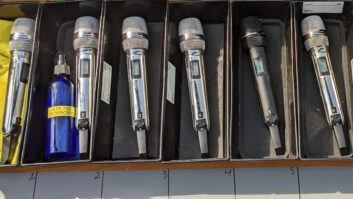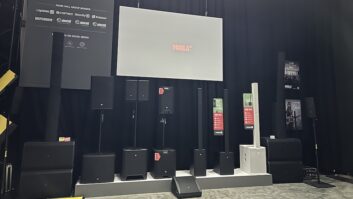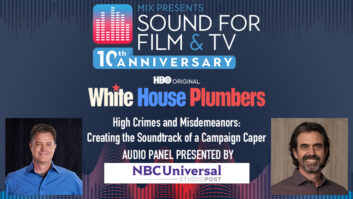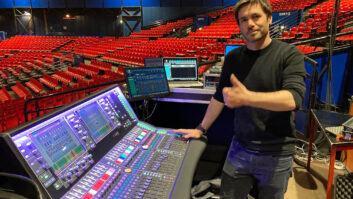NEW YORK, NY—On September 23, with a unanimous vote, the FCC released a Memorandum Opinion and Order that approved the unlicensed use of “white space” spectrum, laying down longawaited rules in an effort to balance the needs of broadband proponents and wireless microphone users alike.
White spaces—spectrum that was left unused during the days of analog TV transmission in order to act as buffers between terrestrial TV channels— have been the subject of ongoing debate in recent years, as the FCC has wrestled with how best to reallocate them.
Unlicensed use of white spaces has been championed by the likes of Google, Dell, HP and Microsoft, which are intent on creating new wireless applications and devices that will use reallocated spectrum for augmented connectivity and communications— a concept that has been coined “Super WiFi” in recent times. Units that would use the applications have been alternately coined White-Space Devices (WSD) and TV Band Devices (TVBD). There was plenty of economic incentive to fuel their lobbying efforts, as a 2009 study funded by Microsoft predicted white-space applications could create between $3.9 billion to $7.3 billion yearly in economic value.
A primary concern for the pro audio community, however, has been that such applications and devices would create interference with critical equipment, such as wireless microphones. After considerable lobbying from the pro audio community, NAB, end users, broadcasters and others, the FCC would appear to have taken those concerns to heart with the new rules
As part of the Order, two channels will be set aside nationwide for wireless mic use—a move that the FCC expects will allow between 12 to 16 mics in a given area to operate simultaneously without interference from devices that will use the newly released spectrum. If a production requires more spectrum for an event such as a sports game or concert, it can petition for a temporary expansion of allocated frequencies during performance times by electronically filing a request with the FCC at least 30 days in advance. A condition of the additional spectrum being granted will be that users will have to prove that available channels have been exhausted, but crucially, a wireless mic user does not have to be a licensed operator to register with the database.
The decision wasn’t a complete win for pro audio proponents, however. Over the last few years, broadcasters and pro audio concerns lobbied for the FCC to require all UHF Band Devices to both use geo-location spectrum sensing technology and check a geo-location database that would monitor existing spectrum uses in a given area.
The FCC’s new rules, however, will only require database checks, making the spectrum sensing technology optional. This is a significant victory for the Wireless Innovation Alliance (Google, Dell and others), which had feared implementing both technologies would make devices significantly more expensive to produce.
In the wake of the new rules, however, both sides declared victory. Though the National Association of Broadcasters declined to initially comment beyond stating, “We look forward to reviewing the details of today’s ruling,” others were exultant.
In a statement, Sandy LaMantia, president and CEO of Shure Incorporated, remarked, “It’s clear that the FCC carefully considered the needs of wireless microphone users while crafting this Order. The reserved channels will provide a safe harbor in which musicians, small theaters, houses of worship, and businesses can operate their wireless microphone systems without interference from new TV Band Devices.”
That sentiment was echoed elsewhere. “We are pleased with the FCC decision, as it recognizes the important contributions to art, entertainment, news and technology that wireless microphones have made,” said Jackie Green, Audio-Technica vice president of R&D/Engineering, who later added, “…the FCC Order has opened the door to our future investment in technical development by making it clear that wireless microphones are here to stay.”
Meanwhile, Richard Whitt, Google’s Washington Telecom and Media Counsel, stated on the company’s Public Policy blog, “We’re glad to see that the FCC appears to have rejected calls to enact burdensome and unnecessary constraints that would have made it more difficult to deploy useful technologies on these airwaves. Instead, the Commission has put forward commonsense rules that will help encourage innovation, while fully safeguarding incumbent signals from interference.”
Some parties took issue with some of the more pointed comments that came from the FCC. Sennheiser USA’s Joe Ciaudelli noted, “In their commentary, the FCC stated that wireless mic technology is spectrally inefficient…. We will continue to innovate. Nevertheless, we believe the FCC may not yet fully appreciate the technical hurdles to increasing efficiency without sacrificing performance. Wireless mics must be compact, operate without dropouts, exhibit negligible latency, and have full audio frequency response. No other technology comes close to meeting these performance requirements. We will continue to communicate these points with the FCC.”
While the Order is a big step forward for the devices, there’s still a lot that has to happen in the coming years before white space devices and wireless microphones start sharing the spectrum. For the FCC’s Office of Engineering and Technology, the next order of business is to decide who will run the geo-location database. Various companies, including Google, have submitted proposals to manage it.
Once the devices finally hit the streets, how should wireless mic operators deal with them? According to Chris Lyons, manager, Technical & Educational Communications at Shure, “First, wireless mic users should determine which TV channels are occupied by TV stations, and which will be reserved for wireless mic use in their location. Second, take inventory of wireless gear and determine how many of your existing systems can fit into those reserved channels. Third, plan ahead for large events that will need extra TV channels; registering in the database can protect those systems. Applying for a wireless mic license can’t hurt.”
Most wireless mic end-users are unlicensed; with the Order not requiring database registrants to be licensed, the FCC would appear to be sidestepping the intimidating effort that would be required to license hundreds of thousands of users. While this would appear to let wireless mic operators off the hook, fine print within the Order indicates that getting licensed might still be more beneficial in the long run.
To wit, Mark Brunner, senior director of global brand management at Shure, remarked, “There’s some interesting language regarding the database application process that could be interpreted as ‘hurdles’ for entry. Based on often-stated objections from TVBD proponents regarding non-licensed wireless microphone users’ access to the database, one could presume that licensed users may face less scrutiny, and NBC, for example, may be granted a registration request more quickly than the local Ribfest. Also, as is the case today, Part 74 licensees have operating priority over Part 15 (non-licensed) users and are able to take advantage of some of the benefits afforded to this Part status, such as a 250 mW operating power limit vs. 50 mW for Part 15. For these reasons alone, for eligible parties, pursuing a Part 74 license may be a worthwhile endeavor.”
Ironically, given the congestion that might occur for wireless microphones when potentially hundreds of mics start vying for the same limited spectrum space, the Order creates a situation where wireless mic systems with smaller or more limited ranges might be more preferable, as since they had less range, they would they be less likely to overlap with other mics from other productions. Of course, that holds true even today, as Sennheiser’s Ciaudelli noted: “In some applications less power is helpful; the Broadway district is a good example. Hundreds of mics are used within a small geographic area, yet reliable, interference-free systems are configured, largely because the transmitters are operated at 10 to 50mW. Of course, good planning, natural shielding from the theater walls and cooperation among the productions also contribute. Generally, you only need higher power for long-distance applications, such as a golf tournament, or if there is a high RF noise floor in the environment. These principles hold true regardless of the presence of TVBDs (WSDs).”
While there’s no knowing how far WSD manufacturers have progressed in product development, the first devices won’t arrive for 18-24 months. Once the units arrive, however, the road ahead for them won’t be an easy one. According to an FCC fact sheet, although most markets have five or more empty channels for WSDs to work in, the nation’s biggest markets, New York and Los Angeles, will have few vacant spaces for them to operate within.
FCC Order
http://hraunfoss.fcc.gov/edocs_ public/attachmatch/FCC-10-174A1.doc
Shure
shure.com
Sennheiser
sennheiserUSA.com







